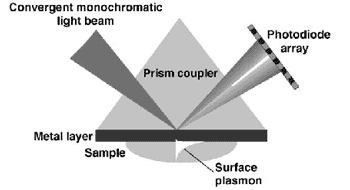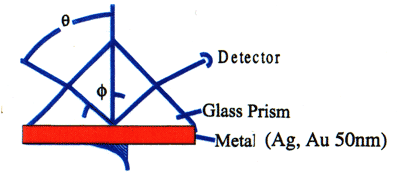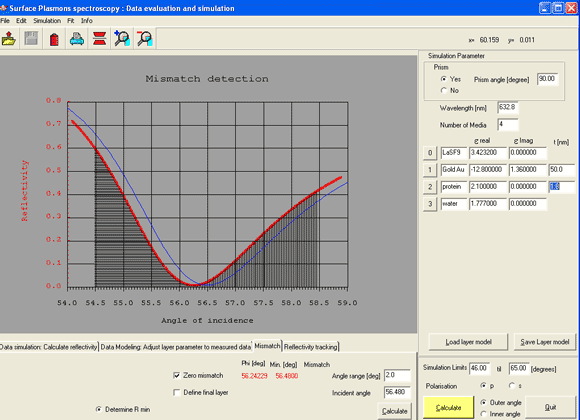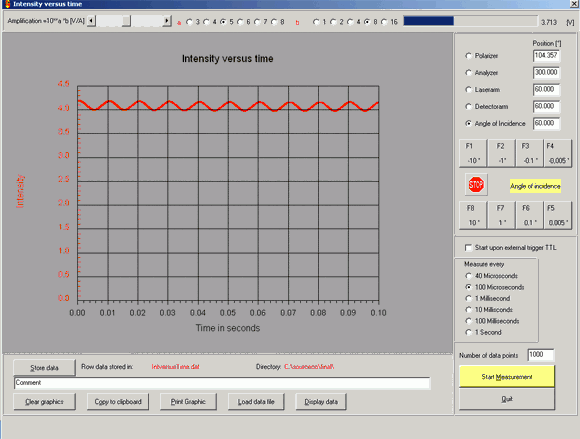表面等离子体共振仪的控制软件:
Please choose:
Theta-Theta reflectivity scan
The Kretschmann configuration is used and the intensity of the reflected light is measured as a function of the angle of incidence. The laser and detectorarm are synchronously moved and the corresponding reflected intensity is measured.
The following input is required: Upper and lower limit of the goniometer setting.

The reflectivity curve is measured and displayed and can be imported by a simple mouseclick in the data evaluation program.
back to top
Fast angle tracking in the kinetic mode
Some commercial SPR instruments use a lens to focus the beam onto the prism base. Within the focus different angles of incidence are produced. The angle range is given by the focal length of the lens and the beam diameter. The reflection curve is then monitored by a PSD or CCD array as sketched in the figure.
These arrangement leads to a trade-off between the dynamic range and resolution of these sensors as a high number of elements have to be interrogated at once.

A more elegant and simple solution is based on the evaluation of the intensity reading of the individual segments of the four quadrant diode of the Multiskop. At the beginning of experiment the four quadrant diode is aligned in a fashion that the intensity in the upper segment A,B matches the reading of the lower segment C,D. The adsorption leads to a mismatch in the intensity reading of the segments. It can be shown that (A+B-C-D)/ (A+B+C+D) is proportional to the angular shift of the resonance. The relative sensitivity is extremely high and was found to be on the order of 10-5 degrees while the speed in the processing is only limited by the electronics.


The upper part of the four-quadrant diode integrates over the integrates over horizontally striped area and the lower part over the vertical striped area. The adsorption of the protein lead to a shift in the resonance and as a consequence a mismatch is detected which turn out to be proportional to the plasmon shift.
A further benefit of this algorithm is the elimination of laser intensity fluctuation due to the intrinsic normalization. For this reason this algorithm is superior to the quite common scheme based on an evaluation of the intensity versus time. A further benefit is the discrimination between a broadening and a shift of the resonance.
Further reading:
M. Schneider, A. Andersen, P. Koelsch, H. Motschmann
Following fast adsorption processes with surface plasmon spectroscopy: Reflectivity versus Mismatch Tracking
Sensors and Actuators, 104(2):276-281, (2005)
 Download PDF Download PDF
Screenddump measurement mode missing
Input: Specify the number of datapoints and the time interval between the subsequent measurements. The limit of the time resolution is 50 Microseconds.
The measurement can also start upon an external trigger (TTL-Puls) which is hooked up to the event channel of the converter. The measurement start after 0.3 Microseconds. Example photochromic transition in a photosensitve unit. The program is started with the flashlight and the intensity is recorded.
back to top
Reflectivity Tracking:
The reflectivity is recorded at a fixed angle of incidence. The shift of the plasmon leads to an elevated intensity which is recorded and analyzed.
Imaging mode: If your layer is inhomogenous you can directly image the inhomogeneity of the surface. The lateral resolution is on the order of Micrometer. Usually the resolution is not limited by the numerical aperture of the imaging system instead it is given by the decay length of the surface plasmon.

Input: Specify the number of datapoints and the time interval between the subsequent measurements. The limit of the time resolution is 50 Microseconds.
The measurement can also start upon an external trigger (TTL-Puls) which is hooked up to the event channel of the converter. The measurement start after 0.3 Microseconds. Example photochromic transition in a photosensitve unit. The program is started with the flashlight and the intensity is recorded.
back to top
Data evaluation
The data simulation and evaluation program is based on Fresnel theory. It calculates the reflectivity of stratified media and can be used for the analysis of your experiment. Several algorithms are implemented including an automatic fitting procedures based on nonlinear least squares routines. A database helps you to quickly edit your layer sample.
Screendump mismatch
The Magnitude of the Mismatch can be optimized by the choice of the lens which defines the angular range Delta-Phi within the focus and by the choice of the the angle of incidence defined by the goniometer setting. The functional dependence is rather complex and has a pronounced extremum.
back to top
Flow-Cell:
Optrel developed a flow cell for SPR measurement ion a kinetic mode.
 Download PDF Download PDF
| 